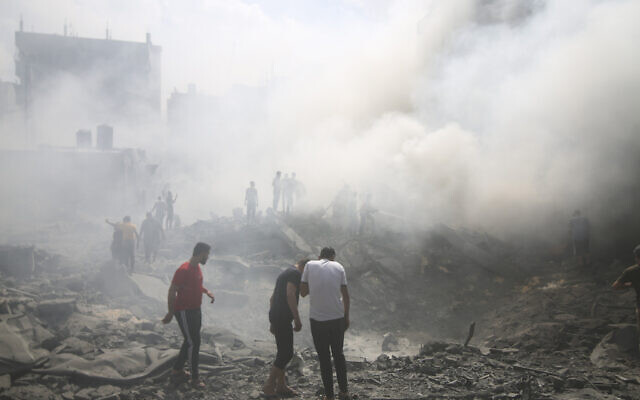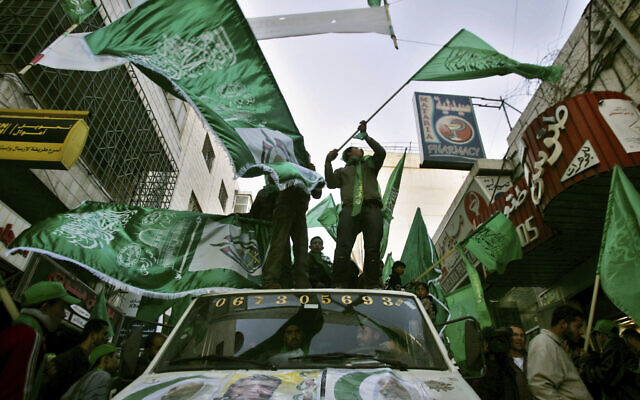In the three and a half decades since it began as an underground terror group, Hamas has pursued a consistently violent strategy aimed at rolling back Israeli rule — and it has made steady progress despite bringing enormous suffering to both sides of the conflict.
But its devastating massacre in Israel over the weekend marks its deadliest gambit yet, and the already unprecedented response from Israel aims to destroy its capacity to harm Israel and threatens to bring an end to its 16-year rule over the Gaza Strip.
Israel has said its response to the Hamas assault — in which at least 1,300 people were killed in Israel, most of them civilians and many slaughtered in their homes, with some 150-200 dragged into Gaza as hostages — is intended to “wipe the terror group from the face of the earth,” in the words of Defense Minister Yoav Gallant. Gaza, where 2.3 million Palestinians have nowhere to flee and where 1,537 have already been killed, is facing growing devastation.
Hamas officials say they are prepared for any scenario, including a drawn-out war, and that allies like Iran and its proxy terror group Hezbollah in Lebanon will join the battle if Israel goes too far.
“I don’t think anyone really knows what the endgame is at the moment,” said Tahani Mustafa, a Palestinian analyst at the Crisis Group, an international think tank. But given the amount of planning involved in the Hamas assault, “it’s difficult to imagine they haven’t tried to strategize every possible scenario.”
Shaul Shay, an Israeli researcher and retired colonel who served in military intelligence, said Hamas “miscalculated” Israel’s response and now faces a far worse conflict than it had anticipated.
Palestinian terrorists take control of an Israeli tank after crossing the border fence with Israel from Khan Younis in the southern Gaza Strip on October 7, 2023. (SAID KHATIB / AFP)
“I hope and I believe that Israel will not stop until Hamas has been defeated in the Gaza Strip, and I don’t think that this was their expectation before the operation,” Shay said of Hamas.
From upstart insurgence to proto-state
From its establishment in the late 1980s, on the eve of the first Palestinian intifada, or uprising, Hamas has been committed to so-called “armed struggle” and the destruction of Israel. At the height of the peace process in the 1990s, it launched scores of suicide bombings and other terror attacks that killed hundreds of Israeli civilians. The violence only intensified with the breakdown in peace talks and the far deadlier second Palestinian uprising in 2000.
Hamas terror attacks were met with massive Israeli military incursions into the West Bank and Gaza that exacted a far heavier death toll on Palestinians. But as the violence wound down in 2005, Israel unilaterally withdrew its soldiers and some 8,000 Jewish settlers from Gaza, while maintaining tight control over access to the enclave by land, air and sea.
Hamas claimed the withdrawal as vindication for its approach, and the following year it won a landslide victory in Palestinian elections. In 2007, after bitter infighting, it violently seized Gaza from the internationally recognized Palestinian Authority.
Over the next 16 years, through four wars and countless smaller battles with Israel that rained devastation upon Gaza, Hamas only grew more powerful. Each time it had more rockets that traveled farther. Each time its top leaders survived, securing a ceasefire and the gradual easing of a blockade imposed by Israel and Egypt. In the meantime, it built a government — including a police force, ministries, and border terminals with metal detectors and passport control.
And what of the thousands of Palestinians killed, the flattened apartment blocks, the crumbling infrastructure, the suffocating travel restrictions, the countless dreams deferred in Gaza, a 40-kilometer (25-mile) coastal strip sandwiched between Israel and Egypt?

Palestinians look for survivors after an Israeli airstrike in the Rafah refugee camp, southern Gaza Strip, Thursday, Oct. 12, 2023. (AP/Hatem Ali)
Hamas blamed Israel, as did many Palestinians. The Hamas government has seen only sporadic protests over the years and has quickly and violently suppressed them.
Negotiations and their discontents
The Palestinian leadership in the West Bank recognized Israel and renounced the armed struggle over three decades ago, hoping it would lead to a state in the West Bank, Gaza and East Jerusalem, territories captured by Israel in the 1967 Six Day War.
But the talks repeatedly broke down. Israel has blamed incessant terrorism, Palestinians’ repeated rejection of peace offers and an inability to truly accept the Israeli state as valid. Palestinians cite Israel’s relentless expansion of settlements, now home to more than a half million Israelis. There have been no serious peace talks in well over a decade, and the Palestinian Authority has become little more than an administrative body in the 40% of the West Bank where it is allowed to operate.
Palestinian Authority President Mahmoud Abbas, 87, has been powerless to stop settlement expansion, settler violence, home demolitions, or what Palestinians claim is the erosion of longstanding arrangements around Jerusalem’s Al-Aqsa Mosque on the Temple Mount. He has been sidelined during every Gaza war — including this one — and the Palestinian Authority is widely seen on the streets as a corrupt accomplice to Israel’s military rule.
“Palestinians have tried everything from elections to boycotts to the (International Criminal Court) to engaging in a supposed peace process,” said Mustafa, of the Crisis Group. “You’ve had one of the most conciliatory leaderships in the entire history of the Palestinian national movement, and that still hasn’t been enough.”
Israeli leaders take issue with such claims, arguing that beyond renouncing violence, Abbas and the PA leadership have rejected numerous overtures over the years that would end their further claims toward Israel proper, while indirectly supporting terror by paying monthly stipends to jailed terrorists and to the families of dead ones — all those Fatah and the PA celebrate as “the resistance.”
Still, the scale of last weekend’s attack takes Hamas’s approach into uncharted territory.
“It is unclear what Hamas’s endgame is beyond either fighting to the death or liberating Palestine,” said Hugh Lovatt, a Mideast expert at the European Council on Foreign Relations.

File: Palestinian supporters of the Hamas terror group wave green Islamic flags during a pre-election rally in the West Bank town of Ramallah, January 23, 2006. (AP Photo/Muhammed Muheisen)
The latest attack marks a “complete strategic rupture,” he said.
“Despite conducting attacks against civilians in the past and fighting previous wars against Israel, [Hamas] did also simultaneously engage in political tracks,” including negotiations with Abbas’s Fatah movement and even tacit coordination with Israel, Lovatt said.
“Now it appears to have fully embraced open-ended violence as its long-term strategic choice.”
For Israel, victory could again prove elusive
Israel appears increasingly likely to launch a ground offensive in Gaza. It could reoccupy the territory and try to uproot Hamas, in what would surely be a long and bloody counterinsurgency. But even that might just drive the group — which is also present in Lebanon and the West Bank — back underground.
And Hamas has a horrifying trump card that could give Israel pause.
Hamas and the even more radical Islamic Jihad terror group are holding some 150-200 men, women, and children who were captured and dragged into Gaza. Hamas’s armed wing claims some have already been killed in Israeli strikes and has threatened to kill captives if Israel continues its attacks.
Hamas may succeed — as it has in the past — at trading them for thousands of Palestinian prisoners held by Israel in a lopsided deal that Palestinians would see as a triumph and Israelis as agony.
Israel has faced virtually no calls for restraint in the wake of Hamas’s massacre, but that could change if the war drags on.
In the end, the two sides could find themselves returning to the status quo: an internationally mediated truce, with Hamas ruling over a devastated and aid-dependent Gaza, and Israel redoubling security along its frontier. That too, for Hamas at least, would look like a victory.
But Israel seems to have little appetite for a prisoner swap that would be viewed as a display of weakness by its many enemies. And the Israeli public sentiment, across political camps, appears to be a grim determination that this time the fight must lead to a clear defeat for the terrorists and a permanent change to the state of affairs along the southern border — whatever the costs.